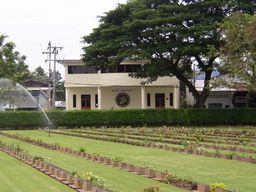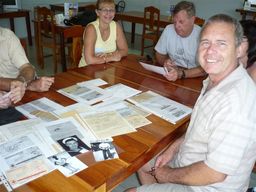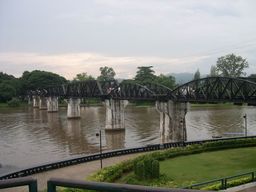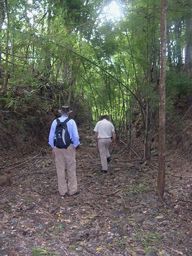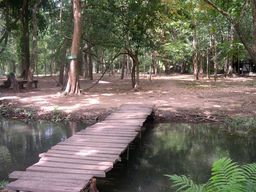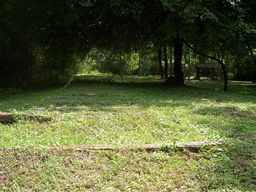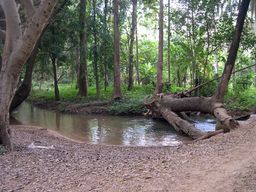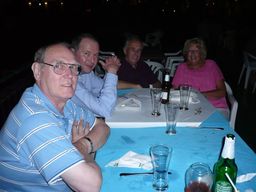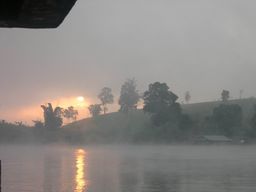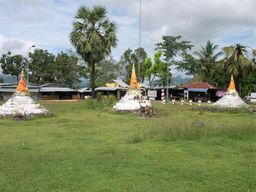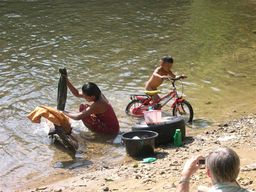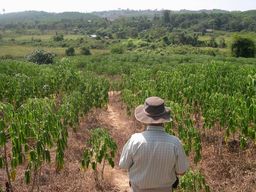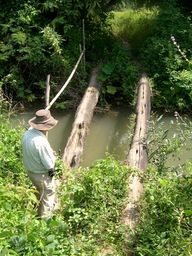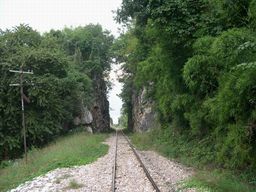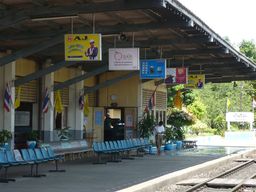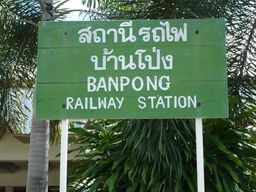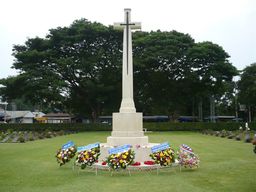Thailand Trip By Mike Nellis and Keith Andrews | ||||||||||||||||
|
The following report was submitted by Mike Nellis after returning from his second pilgrimage to the Thailand-Burma railway accompanied by Keith Andrews. Both Mike and Keith are amongst the many thousands of people in the world who had a relative who worked on this railway as Prisoners of War and/or slave laborers of the Japanese during WWII. Thailand Trip By Mike Nellis and Keith Andrews –
11.00am on Friday 2nd November 2007 saw me ready and waiting for my taxi to take me to the station where, once the train arrived, I found my reserved seat in Coach ‘H’ First Class, the quiet coach. [Why First Class? Because it cost me £31.35 each way single fare, that is with ‘An Old Gits Ticket’ First Class, rather than £54.00 each way standard rate! No sense in their pricing range what so ever!] A good trip down to London, arriving on time at 3.15pm. The trip across from Euston to Leicester Square on the northern line, then on to Heathrow on the Piccadilly Line was rather congested and bloody hot! Then it was a huge walk to Terminal 3 and wait for my traveling companion of the first trip, Keith Andrews to arrive. [Keith was traveling down by express coach from East Midlands airport]. What a boring place, hardly anywhere to sit, no litter bins, and an ambiance of a huge half finished warehouse to boot. However, Keith duly arrived and we headed for the check-in desk, to get rid of our luggage and to get into the Departures Lounge. As we were taking some books for the TRBC, and as I had added them to my suitcase, I finished up 4 kilo overweight, but they let this pass without charge. Mind you, the lady on the desk, was not very interested in the fact we should already have our seats booked, all she wanted was to get us out of the way I think. Departures was bedlam! Hundreds of people all jetting out of the country at the same time! All colours, race, creed and religion it struck me. Still eventually we made our way through the X-ray machines into the final Departures Lounge. Just before 9.30 pm we were allowed to board, our group in the Finesse Class [which is one up from Economy and one down from Club] being the last group to board. We found our seats and were just getting comfortable when we were asked to move. We had not been given the booked seats after all and were relegated to a group of four in the centre of the cabin. Keith was not very chuffed at this at all! Still, we had a good flight leaving at 22.00 hrs and even managed a bit of sleep on the way across. EVA Air is a good company to fly with and looked after our every need very well. Duly landing in Bangkok at 16.15 hours on the 3rd November, where we were met by a charming young lady who was to accompany us as our chaperone in our Volvo to Kanchanaburi. The trip northwest took us just about 3 hours and it was quite interesting to see all the changes and the illuminations for the Thai King’s birthday last December, which had occurred since our trip two years ago. The Luxury Hotel was just as before, and we even found our rooms were the same as before. Keith being in 102 and myself in 103.
Our first day was mainly spent catching up on old times and meeting yet more Australians who were looking for information on their Dads. This time it was David Rowe and his wife Allison, who were bringing Rod a parcel of items for display in the Museum, relating to David’s father, Robert Cunliffe Rowe who, like Terry Manttan’s dad, had been on the Australian cruiser “HMAS Perth” which had been sunk in the Battle of the Sundra Straits, prior to them being made Prisoner’s of War. They were traveling with their friends, Stephen Abbott and his wife. Much of the day was spent with the guys at the TBRC catching up on old times and on new developments. That afternoon, we met up with Carol and Ron from COFEPOW, who we were to join on a trip up country with Rod Beattie on the 6th and 7th November at the TBRC and agreed that in the evening we would meet up with them at the Luxury Hotel and all go out for a meal together. So we went out to dinner with them at our favourite restaurant the Ban Rau. We had a great meal, paying the bill, which came to the vast sum of 772 baht for the 4 of us. [This is about £11.00 for 4 starters, 6 different main course dishes and 3 litres of Singha beer!] Monday 5th November at 8.00am saw us again at the TBRC checking on our arrangements for the day, as Keith and I intended traveling on the Railway as far as Nam Tok [which is where the railway now ends] and meeting up with Rod there as he had suggested that we might “have a bit of a stroll through the jungle”! So we duly put on our walking boots and set off to catch the train from Kanchanaburi to Nam Tok, which departed at 10.50am. Rod had told us to get the special Tourist ticket and boy am I glad we did! This meant that there were two special coaches, which go at the front of the train, as against the rest of the carriages. We paid our 300 baht [just over £4.00] and were sent along the platform to the far end. The rails stretched off into the distance. These were the rails which our fathers had struggled over for three and a half long years and which had claimed so many young lives. Across on the far side of the station there were two carriages all on their own, of which the first one was soon filled by a gaggle of bodies from one of the many River Kwai resorts which now seem to occupy so many of the sights of the old POW camps. The train drew into the station with a mournful siren sound, almost like a wail for the lost souls of the railway itself. We duly mounted one of the coaches, with their bare wooden plank seats and Asiatic toilets! Then we realized that where we were supposed to be was in the second of these two coaches in the siding, which by now, after the engine had been detached from the front of the train, had shunted back to collect these two odd coaches from the siding. What luxury awaited us! Great big cushions to sit upon and a steel table to rest our belongings on. Posters on the wall and numbered reserved seats to boot! Packets of food and drink, coffee [too hot to drink and which mainly finished up washing around the table top at that!]. bottles of water and face cloths to clean up with. Every thing you could wish for! Even a mobile young lady selling caps and tea shirts!
Rod met us at Nam Tok Station, which at present is undergoing yet another transformation, with concrete bases being laid, evidently to take more market/tourist stalls to boost the fragile tourist economy of Thailand. [Nam Tok is roughly where Tarsoa Station once stood, it lies roughly one kilometer from Tonchan South camp which itself lies above the playground of the tourists and Thai’s alike, at the waterfalls of Tam Tok. But more of that a bit later!
Image “POW Campsite Tonchan South” Rod took us in his ‘old red truck’ up the ‘old road’, which is the road that the POW’s would have walked to get either to Tonchan South or to follow on the jungle trail to those camps and work places further north. Past the track junction to the limestone caves, which lay above the campsite, you come to a point where the road crosses the stream and heads north. It is a strangely quiet, shaded and almost melancholy place. On the left hand side of the road as you breast the rise, would have been the AIF camp and the transit site for ‘F’ and ‘H’ Force as they trudged along to their next resting point. Just off the track lay the cookhouses and across the stream lay ‘The Tiger’s haunt and the Japanese enclosure. On the eastern side of the stream lay the Tamils’ camp and to their right the Chinese camp. Where the two branches of the stream meet would have been the sawmill and beyond this in the jungle clearing is where the Japanese Engineers lived. This, where the Tamils lived, is the site where the cholera epidemic commenced. Down the road at the very far end, in the direction of the waterfall lay the main body of the POW Camp. To the right across the stream lay the huts for the POWs in ‘C’, ‘H’ and ‘K ‘ battalions, close by was the Hospital hut and nearby was the Officers’ hut. To the left of the stream, which split the camp in two, was the tented area, which soon became the choleras’ hospital tents. Here there is now a cultivated lemon grass field. This is close to where the cholera cemetery was eventually established. Near its site is now a Thai house and work area. At the top and to the left of the waterfall lay the cemetery area, which is now fenced off with a low hedge and flame trees planted in it. There is still a rudimentary wooden bridge to cross the stream to take you to the POW campsite, but a modern house now stands where the huts used to be. It is just so sad that there is no form of signage to indicate that there used to be a POW camp here, and the people we spoke to as they passed by were surprised when this was explained to them. [In fact, half close your eyes and the slow stream of people wandering up the track could well have been POWs coming to collect their meals. Only they were too well dressed and fed of course!] I could never understand why my dad and three others managed to attract the unwarranted attention of ‘The Tiger’, which resulted in them receiving the brutal beating they got with bamboo and an iron stake when they were caught passing small amounts of food to the lingering trail of members of ‘F’ and ‘H’ Force, until we visited this spot and Rod explained it. First up, Dad was QM and, along with others, was responsible for the food arrangements and distribution at South Tonchan, but by giving away some of their own rations, they were unknowingly decreasing the rations available to the members of their own camp. So, just possibly, they deserved a bollicking, but not the brutal beatings, for their indiscretion. Secondly, but then Dad had already had a run in with ‘The Tiger’ at Wampo which had indirectly led to him being moved to Tonchan South. So maybe this also had something to do with it? Plus they were all tall men. Who knows? I can’t ask the questions now. The waterfall? What had that got to do with the camp? Well my dad never mentioned it, as did many others. The reason being, as Rod explained, after the end of the wet season the stream still runs, but the waterfall becomes nothing more than a trickle running over the limestone cliffs. As the majority of the POW’s either followed a track along the edge of the escarpment or along this main track at the top of the camp to get to and from work, they generally would not notice it. Or so it would seem. Even though the railway actually runs on a trestle along the bottom of the falls directly below the steep face of the cliff, I am led to believe it was not an unusual occurrence whilst building the railway, and although it would attract our attention, men working as they did at this time and suffering the indignities and illnesses which they did, would have little time to admire the beauties of nature.
Image “Track bed at Shimo Nikke”
Image “Site of the Cookhouse Tonchan South From here Rod took us back down the road and about a couple of kilometers up the 323 main road, parking at the end of the ‘Amarco’ barrier on the hillside, we walked back down the road and passed into the jungle. This to us was a ‘new’ section of cuttings, bridges and track bed, which was constructed by the POWs from Tonchan South, some two kilometers away. Some 50 yards off the road, we came across the first cutting, part of which is now filled by the spoil taken when they constructed the new 323 road which sweeps off towards the Three Pagoda Pass. What is interesting about this cutting is that the spoil taken from it’s construction still lies undisturbed some 65 years after it was first placed there. What makes it even more surprising is the fact that the cutting is about 20 feet deep, so just how did they get the spoil from the bottom to the top? The answer lies in the vertically drilled holes spaced at intervals where some form of ladder was affixed to enable men to climb up to the height and deposit the baskets of rubble in piles some six feet high scattered in places along the 50 or so yards of the length of this first cutting. Than we approached our first bridge site. Some 20 feet deep and about 20 feet across. Not too difficult to bridge you might think but the basic floor of the jungle here is mainly carboniferous limestone, similar in structure to the famous limestone pavements close to where I live in Cumbria at Orton Scar. These only leave shallow holes, which have filled over the centuries with leaf and mould which will only support slender saplings and tangles of low growth of trailing vines and creepers. No big teak trees or large stands of bamboo. [One to ponder over for a moment]. The cutting and track bed are still in very good condition, hardly having been disturbed over the past 65 years, rotting sleepers lie where they were placed and the track ballast still outline those which have failed to survive. We struggled on, covering a landscape, which is very little overgrown, other than small stunted shrubs and cloying, clinging creepers, which grab and restrain your every movement. In a distance of about one and a half kilometers we passed over the site of 4 bridges, one about 50 feet deep and some 25 feet across, and 2 about 20 foot deep and some 20 foot across. Suddenly we came across the final chasm some 80 feet deep and about 80 foot across! On it’s edge stood a concrete placement for a bridge support, about 20 feet down into the chasm lay another cut into the sheer cliff face. Immediately springing to mind, how the Hell did they get down there to put the concrete formers in? Not only that, where did they mix the concrete? How did they get it to these almost impossible to reach places in the first place? Did they have ladders? Not from the bottom they did not, it is just too difficult to reach. Were the POWs lowered down on ropes? Who knew to carry the ropes? [I must admit I have a very grudging respect for the original Japanese railway men who had to suffer this inhospitable jungle in order to survey it before our lads had to put it in place. Not for those there at the same time as our lads, but for those who went before. Not an easy task in any way]. Back to reality, where did they get the trusses for the bridge? Well the answer for that lies across the other side of what is now the main road. Higher up in the jungle and closer to the camps at Tonchan South and Tonchan Main. Here they must have cut the trees, adzed one side to make it flat, [hence the sawmill!], and then struggled some kilometers to the required bridge sites. [Rod explained that within the immediate area of Tonchan South there were eight bridges and the huge trestle over the waterfalls to the area we were exploring.] We called it a day at this vast chasm, as we could not see an easy way to circumnavigate it. Not only that but, walking away from it some ten yards, you did not even know it was there! We then followed the trail that the POWs would have taken to take us back to the road for Tonchan South. Trail! It took us over four and half hours to simply walk in and out again! If it can be called walking, following the rough limestone and boulder strewn track, through the cuttings, up and down where the bridges once stood, stumbling over a misplaced landscape of limestone outcrop, cloying, clinging, and trailing creepers, grasping at saplings to try to keep you upright, only to have your fingers and hands caught by the instant pinprick of pain as you disturb the hidden insect inhabitants of such trees. Pausing for a while to try to catch your breath in the searing heat, only to find your exposed flesh and boots crawling with red and black ants, as long as a mans thumb-nail, all seemingly eager to catch hold of you with their mandibles whilst directing minute streams of formic acid into your very being! Oh the joys of jungle trekking! Struggling to put one foot in front of the other over this uneven and undulating ground. Overshadowed by the lush canopy over your head which blots out the sun. Fighting with every step to remove yourself from what, 65 years ago, would have been a green Hell. Where every facet of vegetation within every footstep would grasp and prickle, tying your feet in never ending tendrils of creeper. Seemingly determined to hold you fast within it’s harsh boundaries. [Oh! How I feel for our fathers, for us it was relatively easy, soaking wet and out of breath, prickled and stung, but knowing that soon we could wash away the pain and ache of out steady toils. Not for them such luxuries. It makes you so much more aware of just how brave they really were. God bless ‘em all!] A steady trip back to Kanchanburi, the silences telling their own stories. We met up with Carol, Ron and Terry and his young lady and her two children for supper at our usual eating-place. Eating out in the balmy evening air was quite something else. This time we had no arguments about the bill! Keith saw to that.
Next morning bright and early, we met up at Rod’s office for our trip ’up country’. This was to be fairly easy, as Rod knew our limitations. The intention of this trip was to allow Carol the chance to follow the track of her father in ‘F’ Force, a trip he was regrettably not able to return from. Our first stop was to be the site of Lat Ya, where the troops would have camped for the night. From here we moved on to Tha Dan, the Elephant Camp and then on to Tarsoa hospital camp and on to Tonchan South, where Carol’s dad would have passed through. [Who knows maybe our fathers met and passed like ships in the night?] From here we headed further up country, passing by the other Tonchan Camps, the site of where the Kannyu camps were, until reaching Kinsaiyok Station calling at the site of Tha Khanun South for our lunch. Following lunch we traveled on to explore the cutting between Shimo Ni Thea and Ni Thea [Niki]. One highlight was stopping off at the viewing point on the shores of the lake and finding that the post erected by Nagasai ‘In memory of the Japanese engineers etc, who died on the railway and now who lie beneath the waters of the lake’ - has been damaged by white ants and is now in danger of falling over! [Oops! Sorry! ] Our journey was broken overnight at the Pornphailin Riverside Resort which is very nice, except that when it was built someone forgot that if you build something in the dry season, when it rains the level of the lake rises and hence the ground floor apartments were under water until the level drops! This does not seem to worry the Thais at all, they just let it happen, dry out the previously submerged apartments, re-furbish them and carry on as if nothing has happened! A beautiful setting and so, so peaceful. Keith and I had to share an apartment [as the others were under water!] with huge separate double beds. I awoke as usual at 4.00 am and having laid for an hour or so, got up, showered and dressed and went out on to the balcony. What a morning. The mist hung across the surface of the water like a slowly moving curtain, broken by glittering shafts of light as a fish rose to take some insect, instantly plunging back into the depths. Keith came to join me and we watched the sinuous, supple movement of a snake swimming effortlessly by. Propelling itself along the shoreline, it’s head breaking the water leaving a v-line striking out behind it, heading off for the grass and foliage on the fringes of the lake. The silence of the morning broken only by the putt-putt of a long tail boat gliding effortlessly through the billowing mist which lay over the lake’s surface. The softly undulating ripples from the passing boats, slip-slopping against the steps of the submerged apartments. Funny to think that a builder would not remember that the level would rise to such a degree thereby making our first floor level sit only some 4 feet above the water’s surface!
It is now 6.40am on the 7th November 2007 the whole of the lake is lost in the silence of what could be a chilly and misty November morning in the UK, except it ain’t! Very little is stirring on the water except by 7.20am the sun is starting to break through the mists along our side of the lake and with it comes the start of the heat of the day. At present it is somewhere about 20 to 22 degrees and the sunlight is turning the far side of the lake into a mysterious broken outline, with the fronds of mist rolling back and forth seemingly endlessly across the water, suddenly hiding everything from view. Just then the distant echo of the Burmese Chedi (Pagoda) bell rings like a whisper through the mists. This starts some animal to bellow in a low way, broken yet again by the trailing putt-putt of a long tail, a spoken voice, lost in the depths of the shadows breaking the silence, and then is gone.
Image “Washday for the locals” Leaving our overnight halt, we headed in the general direction of Three Pagodas Pass on the boundary between Thailand and Burma which is firmly closed. We stopped off at the site of the bridge at Songkurai, where some of the original timbers still lie within the coffee shop there, along with many items that have been found in the location. There are one or two small tributes here to those who never returned, including one for a friend of ex POW Bill Lawson and one for the last Australian to die here, Stanley Winstanley. We made our way round and down the little road to Songkurai village at the back of the bridge where the site of the camp still stands, close to the original ford across the river. Here a local lady was washing her clothes in the river, beating them against a tree trunk, which had washed up by the edge of the ford. Playing alongside her were her two naked little boys, dashing in and out of the water with gay abandon. It could have been 65 years ago were it not for the two Triang type cycles the boys wished to pose on! Time just seems to stand still here. Coffee at Three Pagodas, the multitude of establishments built in this God forsaken place, high on the border with shops, coffee shops and industrial complexes, shows just how much the site has developed in the past couple of years, along with fresh temples and the Japanese Peace Temple built on the site of the railway, which was opened on Anzac Day 2004. [Another of Nagasai’s self gratification I fear. Nothing quite like rubbing the nose in it is there?]
Image “Remains of the road Shimo Songkurai” From here we headed back to Kami Songkurai and Shimo Songkurai where again we left the 323 main road and dropped down towards Cholera Hill and the original resting place of so many of those from “F” Force. Rod took us through the tapioca plantations to the gravesite of that last man to die at Songkurai, Stanley Winstanley. His grave site, now empty, is still as it was in 1948, when his remains were recovered and moved into hallowed ground, just slightly overgrown with low grasses and flanked by a patch of bamboo along with the many other empty spaces which lie undisturbed (other than by our footsteps). It is interesting to note that even here humour still stands tall, for an Australian party including ex POWs was expected to visit this and another local site the following day. So Rod, after clearing the site of low growing vegetation, split a slim piece of fresh growing bamboo and left them a note, which read: - “Could not wait gone back to Kanchanaburi!” From here we passed along the rough mud track to the site of the Japanese road bridge, of which only the two decaying teak tree trunks survive, crossing the stream with it’s abundance of fish. Carol was quite moved to know her father once passed over this structure. Rod left a note here as well: - “Been here too!” It reminded us that not everything would have been doom and gloom along their way. After a very late lunch back at Tha Kanun South campsite at the restaurant there, we headed back to Kanchanaburi, well bitten by the mossies etc, but having had a most satisfying trip up country. I feel sure that Carol would have gained much from her memory trip. I know we did. 8th November saw Keith and I doing the ‘tourist bit’, walking down to the ‘Bridge on the River Kwai’ and exploring all the tourist ‘flesh pots’ which beckoned you with their bargain basements! Glad to say, not a lot of Orientals this time round. Last time I had a bit of a problem with one in particular who very nearly went swimming! We decided to visit the new ‘museum’ near the Bridge; just how they have the cheek to call it that fair galls me. For example I don’t remember many of the Allies going to war with Winchester 73’s as their rifle! The TRBC is the one, which is the real museum. We caught a ‘taxi’ back to the TBRC for the sum of 150 baht [about £2.00] for the 3 kilometers, well worth it in the afternoon heat. Then after our usual chat it was back to the Luxury for a few Singha beers, then off for a meal and back to bed. Friday the 9th saw us take a short walk into the town and then down to the old township of Kanchanaburi, along through the market and past the old Town Gate, built to keep invaders [and ‘Farangs’ – Us] out! Past Boon Pong’s shop/house and past the Paper Mill and the site where the Kempi Tai building would have stood. Stopping to photograph the old Paper Mill, which is in quite a semi derelict state, we seemed to upset the Military guard. Granted he did not stop us photographing the place, but it is surrounded by a high-corrugated metal fence some 8 feet high, which in turn has a fabric inner cover to stop prying eyes looking through the gaps in the rusty wall. I wonder just what is going on in there? Not much chance of hopping over the wall of the adjacent bungalow as it’s wall is chock a block with broken glass. I guess they are trying to tell you something here. Interesting, to say the least, and it has quite a horrific background as well so I am led to believe.
Image “Chungkai Cutting” On to the ring of Temples next door to the original J.E.A.T.H. Museum, which was founded back in 1977 by the Monks from the Temple [beyond which is the original cemetery site and cremation grounds]. It is built as a replica of a POWs hut as it would have been with many photographs and newspaper cuttings inside. For 30 baht [less than ten bob, sorry, 50 pence, well worth a look] the only thing that spoils it is a statue of that self-gratifying Kempi Tai interpreter, that damn Nip, at the back of the huts, looking out across the river towards Chungkai. [I am sorry but I find it obscene that he should seem to be everywhere. But why? I have a description of him in my own text, but would hate to upset anybody by including it in this report.] We returned through the old Town Gate to take lunch at the TBRC yet again. This place could well be our second lodging place, but they make you so welcome here. Everywhere we go, we pass old Temples and new ones being constructed. Their proliferation adds so much colour to the area, but reflect so much the difference between the living quarters of the normal people of the country, some of which can only be described as being extremely squalid, and the opulence of these shimmering mighty places of worship. [But that is how they choose to live. It is their belief that the more they can offer the better they will benefit in the next life and far be it for us to comment on that.] For anyone wondering how long it takes to go from the TBRC to the original J.E.A.T.H. and back which is around 3 kilometers, I would guess it took us about three and a half hours including our stop offs, and no rushing at that. Just a pleasant morning’s stroll. To the Bridge is about 45 minutes I would guess. [The only thing I would say is the local scenery is brilliant, but expect to be started back at by the locals. I doubt they see many ‘farangs’ wandering around like Keith and I were doing! I think they thought we were out of the local Zoo or maybe an asylum!] Most ‘tourists’ just pass by in their multi coloured steel and fiberglass ‘sheds’ hurried on by their ‘Guides’ who have a ‘schedule to stick to’ It just reinforces the fact it is so much better to make your own arrangements and go with the flow, using the knowledge and facilities on offer and readily availability at the Thailand-Burma Railway Centre, and the masses of information available to you within the Research Room facility there. [Thanks for that Keith, for he’s the guy that did all our arranging!] A little later we are back at the Luxury for R & R and Keith hears the sound of a band. Now in Kanchanaburi they seem to have a parade for any particular reason, so we pop out to see what is going on and low and behold across the road are Ian and Morag Gerrie, a couple we bumped into by the Bridge two years ago (also members of COFEPOW). How strange to meet a couple from Aberdeen in Kanchanaburi, at a time like this, goes to show how small the world this FEPOW family inhabit! That night we join Carol and Ron at the Pung Wan Resort for supper along with Terry Manttan and his family. The 10th November see us joining the Royal British Legion Tour group for their Service of Remembrance at the Kanchanaburi War Graves Commission Cemetery, where we meet Charles Pearll and Fergus Anckorm, two ex POWs, both of who are now 90 years of age. So you see age is no barrier to a trip to Thailand. Charles is one of the four survivors of the Alexander Hospital massacre. Along with this party we meet Glyn and Julie Cocker, two COFEPOW members whom we last saw in Manchester back in the early part of this year. The service was attended by the Bangkok Pipe Band and buglers of the Thai Army. We follow them on to Chungkai for their service there and Charles takes off with most of the party for a trip back up the river to the Bridge on a long-tail boat [braver man that me I must say!].
Image “Ban Pong Station”
Image “Ban Pong Station today” Later that afternoon we head off with Rod down country, to visit Ban Pong, Nong Pladuk and Tha Muang. First up is Ban Pong. What a surprise, it is a big, big town on the river! I have always been led to believe it was a one-horse shantytown. Just how wrong can you be? The station is exactly as it would have been 65 years ago, the Catholic Church still stands on the opposite side to the station and the campsite is still there beyond the Temple. But the town is a booming hive of commerce. WHY? Well the river of course, it is the place where everything was brought to be stored in the warehouses which still line the streets. Many of them are still as they would have been 65 years ago. The Branch line to Kanchanaburi is still a ‘One Horse Hut’ but this station is not the one where the lads disembarked all those years ago, it is quite some distance away. Their station is really quite big in Thailand railway station terms. The well where they dumped all their side arms and grenades after the warning of a Kempi Tai inspection is still there, only now it is filled in and a flagpole stand in the middle of it! Then it is off to Nong Pladuk, miles out in the countryside. Why did they pick this place I wondered? Rod soon put us straight. It is on the main line, the site is ideal for a collecting point for all the necessary railway equipment, it is a large flat area, bags of room and the line for Kanchanaburi turns off some 500 yards from the station and heads for ban Pong Station. There is still a water tower from the period and the layout of one of the sidings. The Japanese campsite is still very obviously there and the site of the POW Camp(s) is behind the station and where the township now stands. What a surprise! Plus the fact there are hardly any roads into the place, so everything had to come by rail. We turn off the road near Tha Muang looking for a Dutch grave which was there in 1946. About two kilometers down a twisty road we find a Christian cemetery [which are pretty rare in Thailand] and we find some graves decorated with wartime pictures, but no missing soldier I regret.
Image “Cross of Sacrifice Kanchanaburi” The 11th November saw Keith and I at Kanchanaburi Cemetery where we were proud to be able to lay a wreath on behalf of the FEPOW family at the Cross of Remembrance prior to our leaving for Hellfire Pass. Our moment of tribute was a quiet contemplative one for the both of us. We were soon joined by Derek Lawson from the TBRC and his young lady, another Terry from Halifax, who has lived in and worked in Thailand for the past 15 years, and set off for Hellfire Pass to join with Peter Winstanley’s Australian tour group for a Service of Remembrance. The Service was commenced by a tribute from the Pipes and Drums of the Bangkok Pipe band, and very fitting and moving it was too as they played as they marched through Hellfire Pass itself. An equally moving ceremony was held with many wreaths being laid here. Derek laying one for his father’s mate, Keith for the TBRC and I for the FEPOW family. The silence on the 11th day at the 11th hour, brought back many memories, but beyond the remembrance area I could not help but notice the small group of Japanese, who sat quietly and out of our way on the Hintok side of the cutting. Why did they have to be there at this time I wondered? We made our way up to the small Museum, which lies above the cutting, and I must admit I felt like one of the original stragglers, bringing up the rear. I was puffing and grunting like some antiquated beast, but I made it through the red mists eventually. [I know I’m knocking on, but I really must lose some weight if I intend carrying on doing this sort of thing!] The Sunday afternoon saw us being introduced to Beryl Richardson, whose father, George Bloss of the Herts and Beds, had died of cholera at Tonchan South. Rod asked me if I would be prepared to take her out to Tonchan South as she and a friend had hired a car and driver from Bangkok to try to find something about her dad. I was more than pleased to try to help, for my dad was there at the same time as her dad. All I can say is that it was a most emotional visit for Beryl and her friend Rose. I hope she was able to bring some closure through her visit. I am sure she did. It was a most fitting day to make her tribute as she did. I was just glad to try to be of some help and assistance to her. It was also a fitting climax to our visit. Welcome to another member of our ever-expanding ‘family’. The morning of the 12th saw us on our way back home after a slight hiccup, but that’s another story. Back to reality and a huge dose of jetlag! Glad to have gone? You bet! Maybe go again? Try to stop me! But not just yet
|
|||||||||||||||
